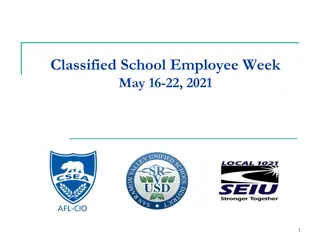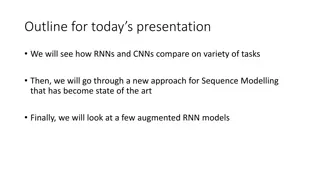Understanding Cross-Classified Models in Multilevel Modelling
Cross-classified models in multilevel modelling involve non-hierarchical data structures where entities are classified within multiple categories. These models extend traditional nested multilevel models by accounting for complex relationships among data levels. Professor William Browne from the University of Bristol introduces the concept, history, and practical examples of cross-classified models, highlighting their application in various fields. The lecture outlines key topics such as nested data structures, historical development, and fitting models to datasets like the Fife education dataset.
- Multilevel Modelling
- Cross-Classified Models
- Nested Data Structures
- University of Bristol
- Multilevel Analysis
Download Presentation

Please find below an Image/Link to download the presentation.
The content on the website is provided AS IS for your information and personal use only. It may not be sold, licensed, or shared on other websites without obtaining consent from the author. Download presentation by click this link. If you encounter any issues during the download, it is possible that the publisher has removed the file from their server.
E N D
Presentation Transcript
Cross Classified Models Part 1 Introduction Professor William Browne Centre for Multilevel Modelling University of Bristol
Lecture outline 1. What are Cross-classified models? 2. Recap of nested models 3. History and Estimation 4. Example for practical the Fife education dataset 5. In lecture 2 we will fit models to the Fife dataset 6. In lecture 3 we will look at extensions to different application areas and more levels of crossing.
Traditional (Nested) Multilevel Model Models that account for the underlying structure in the dataset. Originally developed for nested structures (multilevel models), for example in education, pupils nested within schools. An extension of linear modelling with the inclusion of random effects. Linear models assume independence and so are TOO confident when there is clustering in the data A typical 2-level model is = + + + y x u e 0 1 ij ij j ij 2 u 2 e ~ , 0 ( N ), ~ , 0 ( N ) u e j ij Here i might index pupils and j index schools. Alternatively in another example i might index cows and j index herds. The important thing is that the model and statistical methods used are the same!
Nested Data Structure a) People nested within places: two-level model b) People nested within households within places: three-level model
Cross-classified data structure The data have a two-way cross-classified non-hierarchical data structure n1 n2 n3 n4 Level-2 i1 i2 i3 i4 i5 i6 i7 i8 i9 i10 i11 i12 Level-1 s1 s2 s3 Level-2 Each school draws their students from several different neighbourhoods Children living in the same neighbourhood often attend different schools The school and neighbourhood hierarchies are crossed with one another Other examples include Students within primary schools crossed with secondary schools* Occasions within students crossed within schools Scores within students crossed with raters * Example we will cover in the practical
History Many nested applications, and as a result specialist software packages developed in education (MLwiN, HLM, VARCL) in the 1990s due to the obvious hierarchies in education data students nested within classes nested within schools. Cross-classified applications appeared earlier in animal breeding experiments and some of the first algorithms were produced by Thompson and colleagues on the back of pioneering work on REML (Paterson and Thompson, 1971, Gilmour, Thompson and Cullis, 1995).
Estimation Markov chain Monte Carlo (MCMC) methods (used in this lecture) Implemented in MLwiN:MCMC, R:MCMCglmm, Stata:bayes, WinBUGS Computationally efficient and can handle big datasets and complex multiple membership models easily Maximum likelihood estimation (MLE) Implemented in all software, but can usually only fit hierarchical models (an exception is R:lme4) However, it turns out that it is possible in some software (e.g., MLwiN:IGLS and Stata:mixed) to reformulate and therefore fit cross-classified models as constrained hierarchical models (Rasbash and Goldstein, 1994) Unfortunately, this reformulation is computationally cumbersome for all but the smallest of datasets and simplest of multiple membership models
Example: Fife Education Dataset Dataset from Fife in Scotland that was used by Rasbash and Goldstein (1994) when they first introduced extensions of the IGLS algorithm for cross-classified models. Dataset contains 3,435 students from 19 secondary schools and 148 primary schools The response is a total attainment score based on national examinations taken at the end of compulsory schooling (age 16) which ranges from 1 to 10 Dataset has several student level predictors (mother and father education, verbal reasoning intake score, choice of school, social class, gender) that can be used to explain variation in attainment.
Data frame for attainment data Data frame for eight selected students who attended secondary schools 1 and 2 Higher-level IDs sid Level-1 ID Response Level-1 covariates med pid pupil attain vrq choice 1 1 1 1 2 2 2 2 1 1 5 5 17 8 46 44 3 8 28 1 9 6 101 89 112 84 76 103 102 94 1 1 0 0 1 0 0 0 1 1 1 1 1 1 2 1 10 2 3 5 3 2 12 12 14 14 In cross-classified data, we must use unique identifiers for every higher classification attain: exam score (grade converted to number and treated as normal)
Scatterplot of the attainment data by secondary school and by primary school
Cross-tabulation of primary schools by secondary schools It is always helpful to visualise cross-classified data as a cross-tabulation Here we examine 4 secondary schools and 10 primary schools Primary School 10 17 1 45 2 7 4 1 6 8 13 16 36 24 55 25 35 27 43 1 28 15 1 4 6 7 8 9 Sec School Students are nested within the cells of a two-way cross-classification of primary schools-by-secondary schools. Secondaries draw their students from many different primary schools Primary schools send their children to different secondary schools though many are feeder schools with the bulk of children going to 1 secondary. The cross-classification is sparse, most cells are empty
How cross-classified are the data? The 19 secondary schools draw their students from as few as 7 primary schools to as many as 32 primary schools The 148 primary schools send their students to between 1 and 6 secondaries Number of schools 1 2 3 4+ Number of primaries 57 50 26 15 Percentage of primaries 38.5 33.8 17.6 10.1 38.5% of primary schools sent their children to a single secondary school Suggests a system of feeder schooling rather than school choice Only 8.4% of students would have to change secondary school for the data to become a strict hierarchy (i.e., students within primary within secondary)
Summary In this first lecture on the topic we have recapped the idea of multilevel models and shown how not all data structures have a hierarchical or nested structure We have given a little bit of historical background to modelling non-nested data We have introduced an example from education research that has a cross-classified structure In the second lecture we will fit models to this structure before introducing extensions and additional applications in the third lecture.























